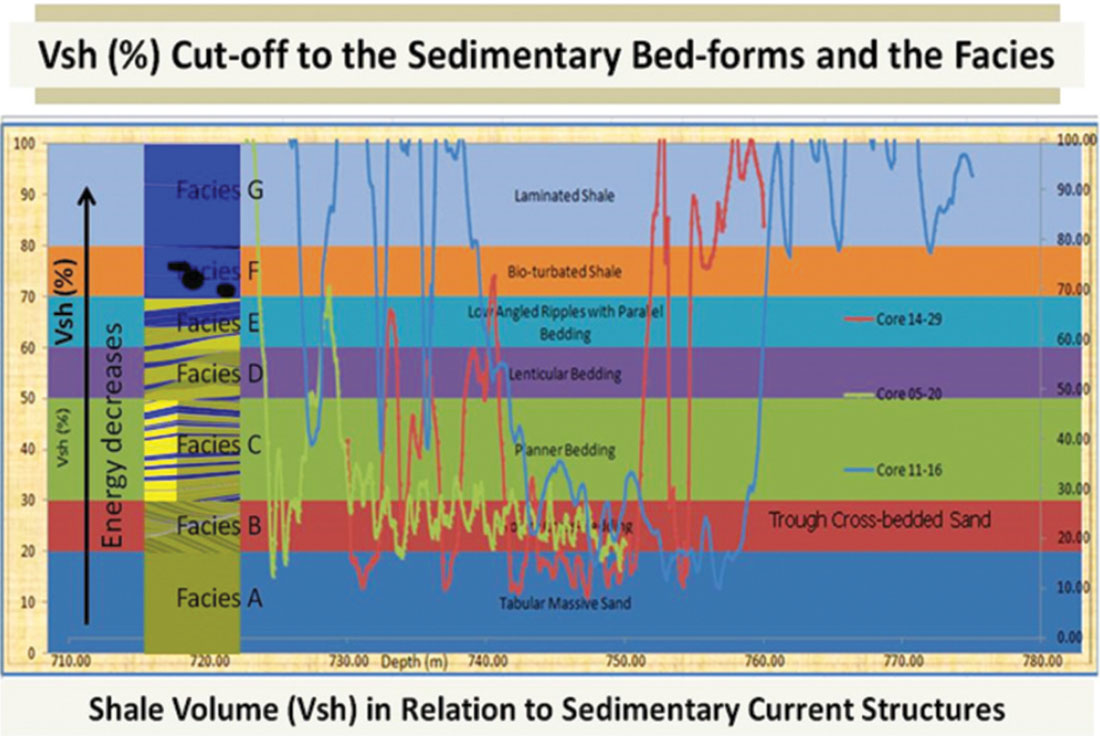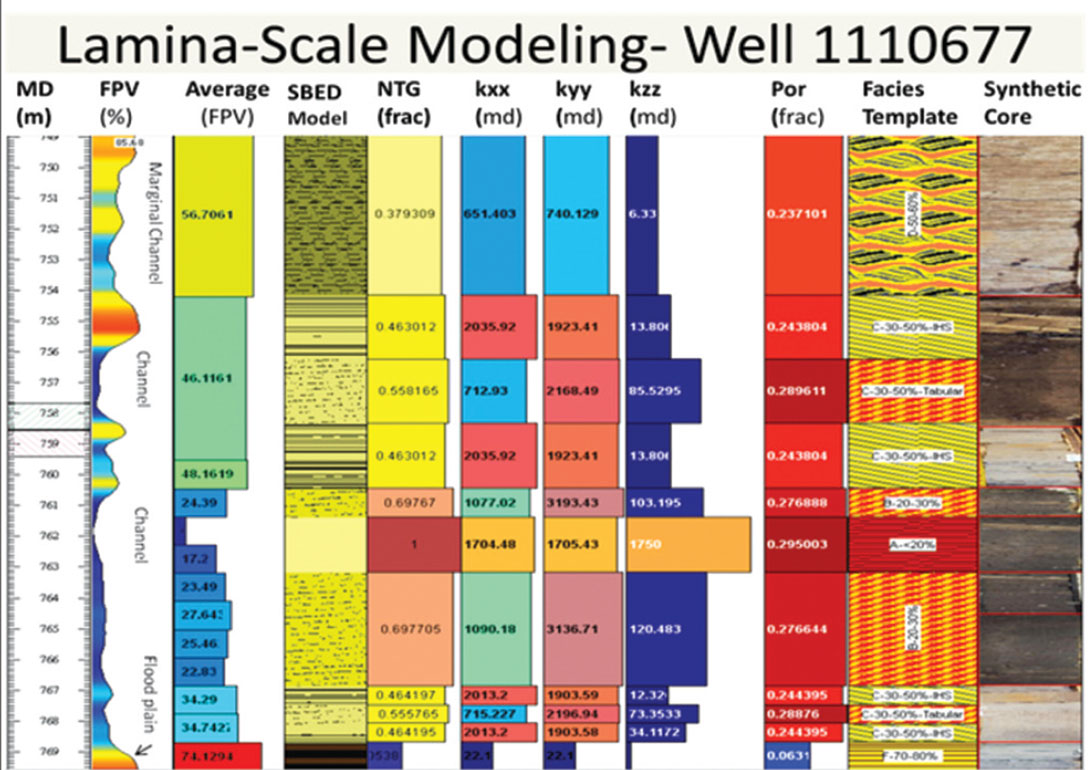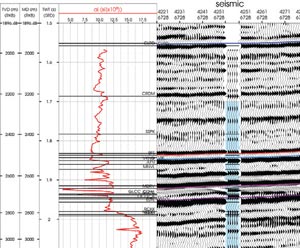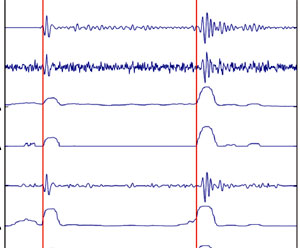Abstract
In geophysics, we often model or “synthesize” measurements in order to enhance our interpretation of geophysical data. Synthetic seismograms often utilize sonic and density logs to produce impedance profiles in order to model seismograms in order for us to pick reflections on seismic data. Synthetic sonic logs, as initially described by Lindseth (1979), utilize seismic data in order to estimate acoustical impedance. Synthetic core uses well log data and geological templates of depositional features in a field to characterize rock properties.
Introduction
Geological and geophysical interpretation involves the creation of earth models whose response describes observed data from geophysical recordings, well logs and cores.
Synthetic seismogram studies have spanned many decades from the earlier days of 1-D modeling as described by Robinson and Treitel (1980) to the more recent descriptions of finite-difference anisotropic viscoelastic modeling as described by Carcione (2007).
The most widely used application of synthetic seismograms in exploration seismology is in the computation of reflection coefficients from well logs in order to tie log information to the picking of reflection events on seismograms. If waves encounter a discontinuity in the acoustical impedance (product of rock density and seismic velocity), this results in a reflected wave. The ratio of the reflection amplitude to the incident wave amplitude is given by the reflection coefficient. By solving the boundary conditions for layer discontinuities for an acoustical wave at vertical incidence (as described in Robinson and Treitel, 1980), we can derive the reflection coefficient for pressure, r, as being the following.

Here represents the density and velocity of the first layer in which the wave travels and represents the density and seismic velocity of the second layer that the wave encounters.
The use of synthetic sonic logs, as described by Lindseth (1979) basically goes in the opposite direction to synthetic seismogram calculations. Instead of using impedance contrasts to compute reflection coefficients, we use reflection coefficients, derived from seismic data and well logs (for the missing seismic bandwidths) in order to synthesize acoustical impedance. In mathematical terms, we rewrite (1) as equation (2) to give:

The implementation of (2) is a type of inversion process which computes acoustical impedance (a synthetic sonic log) from seismic reflection information. This inversion synthesizes logs between wells, generally interpreted in a geological manner, from seismic information. Russell (1988) has described many implementations of this inversion known as recursive (bandlimited), model-based, and sparse-spike inversion.
In addition to well log information, we often base our interpretation of petroleum reservoirs on core that is extracted from the well. In some cases, core is not available but we have access to well logs and seismic data. Our interpretation may implicitly allow us to model the core, in an analogous manner to using seismic data to simulate sonic logs between wells. The modeling of “synthetic core” has been done by Alam (2012) who used logs, knowledge of sedimentary facies, and cores from nearby fields for a heavy oil field in south-western Saskatchewan near the Alberta border. For the purposes of this report, we denote the field as “P-field”, and we now describe this procedure for computing synthetic core.
Methodology and results
The creation of “synthetic core” is an innovative idea of Alam (2012) that utilizes SBED (sedimentary bed) software from Geomodeling Inc. for creation of the facies templates and using unique flow-based upscaling mechanism for rock properties distribution. The basis for the methodology is described by Rider (2002), Thomas-Steiber (1975) and by Wen and Gomez-Hernandez (1998). The variation length of core is on the order of tens of centimeters and is therefore significantly smaller than normal seismic wavelengths (Harris, 2002).
However, from seismic and well log data, we often have knowledge of the depositional environments in a field. The sedimentary structures in these environments have different facies. Each of these facies can be described by templates which describe the rock type and the geometry of deposition. Figure 1 shows templates from Alam (2012) for different sedimentary structures in the P-field reservoir.

Each of these seven sedimentary templates has distinct shale volumes, which can be estimated from well logs. Rider (2002) showed that shale volumes of sediments can be effectively estimated by use of gamma ray logs by the use of a couple of empirical formulae. The shale volume Volsh is given by

Where Ish is the initial estimated shale volume given in terms of the gamma log value
(γlog,) the maximum gamma log value (γmax) and the minimum gamma log value (γmin) by:

Thomas-Steiber (1975) used a different calculation for the shale volume using Neutron and Density logs, where rock’s porosity varies with grain size and density.

Where, φD is the Log Density-porosity and φN is the Log Neutronporosity. (φD)SH and (φN)SH are the ‘Wet Shale Point’s for densityporosity and neutron-porosity values, respectively.
In ‘facies templates’ from the depositional environment, Alam (2012) used both the shale volume calculations and averaged it (later he named it as Fine Particle Volume) for ‘rule-based’ or interpreted facies classification.

Using well logs in the field and knowledge of deposition, we can relate log information to the various facies templates in Figure 1. It shows that the facies can distinctly categorized in terms of the energy of deposition and the interpreted shale volume.
The mapping of the interpreted shale volumes to templates allows us to define sedimentary structures. The cores for corresponding sedimentary structures and interpreted shale volumes can be found in neighboring fields of the same depositional environment. These offset cores can synthesize the cores for the Pfield with its offset reservoir properties. Figure 3 from Alam (2012) shows an up-scaled (from core plug to facies templates) plot of reservoir properties such as porosity and directional permeability obtained from the laboratory data that are used in the construction of synthetic core.

Summary and discussion
In reservoir characterization we are constantly trying to model the Earth based on available information. In the past, both synthetic seismograms and synthetic sonic logs have been constructed based on available information from logs and seismic data. In Alam’s thesis, the same is done for constructing models of synthetic core based on gamma ray logs, porosity logs, templates for sedimentary facies and core from surrounding fields.
Acknowledgements
We thank the sponsors of this research including the Consortium for Research in Elastic Wave Exploration Seismology (CREWES), Consortium for Heavy Oil Research by University Scientists (CHORUS) and the Natural Science and Engineering Research Council of Canada (NSERC). Finally, we thank Geomodeling Inc. for donating the SBED software for use by CHORUS investigators.















Join the Conversation
Interested in starting, or contributing to a conversation about an article or issue of the RECORDER? Join our CSEG LinkedIn Group.
Share This Article